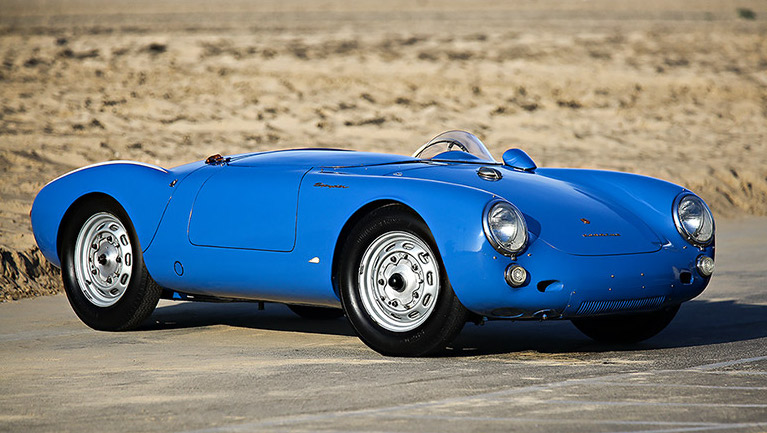1955 Porsche 550 Spyder

The descriptions of the Classic Cars in the Directory were partly generated or supplemented with the help of artificial intelligence (AI). The content may occasionally not always be entirely accurate or factually correct despite careful checking.
The Porsche 550 Spyder is one of the most iconic sports cars in the history of automotive engineering. This two-seater race car was first introduced in 1953 and quickly gained a reputation for its speed, agility, and handling. It was designed to be the ultimate racing machine, with a lightweight body, powerful engine, and cutting-edge technology.
Under the hood, the Porsche 550 Spyder features a mid-mounted, air-cooled, flat-four engine with a displacement of 1.5 liters. This engine produces around 110 horsepower and 83 lb-ft of torque, which is enough to propel the car from 0 to 60 mph in just over 9 seconds. The top speed for the 550 Spyder is just over 140 mph, which is impressive for a car of its size and era.
The body of the 550 Spyder is made from lightweight aluminum, which keeps the car's weight down to just over 1,300 pounds. This, combined with the powerful engine, makes the car incredibly agile and nimble, with lightning-fast acceleration and sharp handling. The shape of the car is aerodynamic, with a long and low profile that is reminiscent of a bullet. The design of the car was optimized for high-speed racing, with features such as an open cockpit, a low center of gravity, and a wide track.
The suspension of the Porsche 550 Spyder is also impressive, with independent front and rear suspension and anti-roll bars. The car rides on four steel wheels with disc brakes all around, which provide excellent stopping power and precise control. The steering is precise and responsive, with a direct-feeling rack-and-pinion system that gives the driver a high degree of control over the car's movements.
Inside the cockpit, the driver and passenger are seated in lightweight bucket seats that provide excellent support and comfort. The dashboard is straightforward and minimalist, with a few essential gauges and controls. The steering wheel is small and wrapped in leather, and the pedals are positioned for optimal heel-and-toe downshifting. The windshield is almost horizontal, which provides an unobstructed view of the road ahead.
Overall, the Porsche 550 Spyder is a triumph of automotive engineering, with advanced technology, a lightweight body, and sharp handling. It is a true sports car icon, and its influence can still be seen in modern sports cars today.
Milestones
- 1953: Porsche decides to create a new sports car for its racing team. - 1954: Development of the Porsche 550 Spyder begins under the direction of engineer Dr. Ernst Fuhrmann. - 1955: In April, the Porsche 550 Spyder makes its racing debut at the Nürburgring. Driver Hans Herrmann finishes third in class. - 1955: In June, the Porsche 550 Spyder wins its first race at the Munster Hockenheim ring in Germany. - 1955: In September, the Porsche 550 Spyder wins overall at the Targa Florio endurance race in Sicily. - 1955: Hollywood actor James Dean purchases a Porsche 550 Spyder, which he later crashes and dies in. - 1956: The Porsche 550 Spyder wins the European Hill Climb Championship. - 1956: Porsche creates the 550A Spyder, an updated version of the original Spyder, which features a revised chassis and suspension. - 1957: The Porsche 550A Spyder wins its class at the 24 Hours of Le Mans endurance race. - 1958: Porsche discontinues production of the 550 Spyder and 550A Spyder in favor of the 718 RSK racing car.Technical
- Engine: 1.5-liter air-cooled flat-four - Power: 110 horsepower - Transmission: 4-speed manual - Top speed: 137 mph - Acceleration: 0-60 mph in 9.3 seconds - Weight: 590 kg (1,300 lbs) - Length: 3.95 meters (155 inches) - Width: 1.57 meters (62 inches) - Height: 1.12 meters (44 inches) - Suspension: Independent with torsion bars and shock absorbers - Brakes: Drum brakes on all four wheels - Steering: Rack and pinion - Body: Lightweight aluminum body designed by Erwin Komenda - Fuel capacity: 34 L (9 US gal) - Production: Only 90 were produced between 1953 and 1956 - Racing history: Won numerous races, including class victories at the 1954 Mille Miglia and the 1956 Targa Florio. Also famously driven by James Dean before his fatal car crash in 1955.